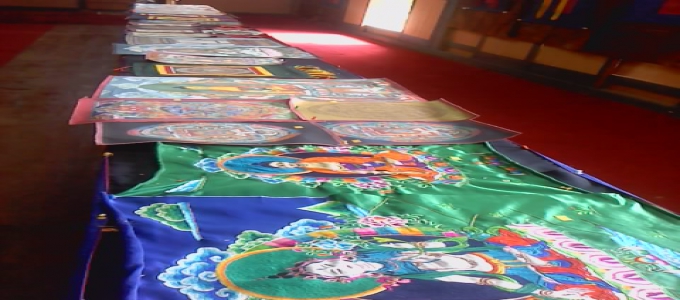
The Live Thangka Exhibition is also a calendared event of the Folk Heritage Museum to promote and showcase the highly regarded styles and work of Bhutanese scroll paintings. The Folk Heritage Museum hosted the Thangka Exhibition from 20 to 25th October, 2014. The week Long program organized by the Folk Heritage Museum highlighted the importance of preserving traditional scroll painting skills along with the live demonstration of Thangka by Bhutanese art experts. Based on technique and material, thangkas can be grouped by types. Generally, they are divided into two broad categories: those that are painted and those made of silk, either by applique or embroidery. Thangkas can thus be further divided into these more specific categories: · Painted in colors (Tib) tson-tang-the most common type · Applique (Tib) go-tang. · Black Background-meaning gold line on a black background (Tib) nagtang. · Block prints-paper or cloth outlined renderings, by woodcut/woodblock printing. · Embroidery (Tib) tsem-thang. · Gold Background-an auspicious treatment, used judiciously for peaceful, long-life deities and fully enlightened Buddha’s. · Red Background-literally gold line, but referring to gold line on a vermillion (Tib) mar-tang. Whereas typical thangkas are fairly small, with painted area between about 20 to 50Â centimeters high, there are also giant festival thangkas, usually applique, and designed to be unrolled against a wall in a monastery for particular religious occasions. These are likely to be wider than they are tall, and may be sixty or more feet across and perhaps twenty or more high. In Bhutan at least these are called thongdrel. There are also larger than average thankas that were designed for altars or display in temples. Somewhat related are Tibetan tsakli, cards which look like miniature thangkas perhaps up to 15Â centimeters high, and often square, usually containing a single figure. These were mostly produced in sets and were usually used in earlier stages of training monks, or as initiation cards or offerings, or to use when constructing temporary mandalas. Another related form is the painted wooden top cover for a manuscript book, giving a long narrow strip, typically some 6 cm by 55 cm, often painted with a row of seated figures in compartments. The techniques for both these forms are essentially the same as for thangka, and presumably the same artists worked on them. Because thangkas can be quite expensive, people nowadays use posters of thangkas as an alternative to the real thangkas for religious purposes | 
